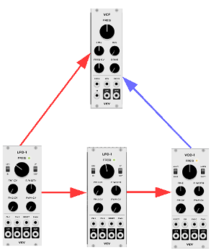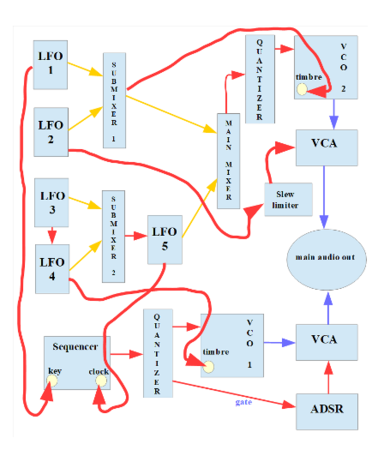Thoughts on Generative Music - Part 9

Thoughts on Generative Music - Part 9
(contains embedded video) If you want to support my work, please make use of the "PayPal" button - thank you very much indeed!
Chapter 3.2.3 excerpt from my book:
https://www.dev.rofilm-media.net/node/331
Basic but Exclusively Generative Techniques
The above mentioned aspect of relations leads us to the real power and meaning of networks of modulations (described in chapter 1): defining and setting relations between otherwise different and independent sonic parameters. Please look at the block diagram. The left LFO modulates the frequency of the right LFO as well as the cut-off frequency of the filter.¨The right LFO modulates the pitch of the VCO.

This means, that when the frequency of the changes of the VCO´s pitch (not the pitch itself) increases, then the cut-off frequency of the filter increases too.
The pitch of the VCO´s sound and the cut-off frequency of the VCF (two musically tightly-knit parameters) stay completely independent from each other, but the frequency of pitch changes and the cut-off frequency (two formerly completely independent and musically not nearer related parameters) are bound into a fixed relation now.
The preset “relations_1.vcv” and the video behind the following link show this patch.
The next graphic shows a more complex example. The modulation network containing 5 LFOs, two submixers and one so called “main mixer” is one of the networks, which I discussed in chapter 1. I have added two voices, which are modulated by this network. Each voice contains a VCO, a VCA (in the video I have substituted this VCA by the channel CV of a mixer) and a quantizer. The VCA in voice 1 (VCO 1) is modulated by an envelope, but the VCA in voice 2 (VCO 2 is modulated from within the modulation network (square wave of LFO 2) with “tamed” flanks (Slew Limiter). Voice 1 has got a sequencer, but the pitch CV of voice two is generated by the mixer called “main mixer”.
The sequencer is clocked by LFO 5, and its key changes according to LFO 1, and the timbre of VCO 1 is modulated by LFO 4.
The timbre of LFO 2 is modulated by Submixer 1.
The preset “relations_2a.vcv” and the video behind the following link show this patch.
But let me talk about the sonic relations, that this patch establishes now.
When the output level of LFO 1 rises, and the rise is not compensated by a decrease of the the output of LFO 2, then the submixers output level rises as well, which leads to a change of the waveform of VCO 2 as if we had manually turned the waveform knob to the right.
At the same time the level of the main mixer rises, if not neutralised by what is coming out of LFO 5. This means that VCO 2 generates higher pitches.
The sonic relation reads (for voice 2):
higher pitches <---> more (inharmonic) partials
lower pitches <---> less partials
But this relation can be destroyed by the sub-net of LFO 3,4 and 5. How often this relation is made invalid (= how often the CV level coming from submixer 1 is partly or completely cancelled out by LFO 3 – 5) depends on the frequency relation of LFO 3, 4 and 5. With similar frequencies the phases of the CV from submixer 1 and submixer 2 are only very seldom opposite to each other.
But the above mentioned relation can also be set invalid by LFO 2 alone. But we wouldn´t hear that, because when the triangle wave of LFO 2 starts going down, the square wave switches to LOW, and therefore the VCA (mixer channel in the video) of VCO 2 is switched off.
But LFO 1 modulates also the key of the sequencer (= voice 1).
The second sonic relation reads therefore:
More inharmonic partials in voice 2 to means increasing key values (C → Csharp → D etc.) of voice 1 most of the times.
Let´s look at the other modulation of voice 1 now.
When the level at the output of LFO 3 rises the frequency of LFO 4 rises as well, and with that the frequency of changes in the timbre, the spectrum of VCO 1. At the same time the frequency of the changes of the output level of submixer 2 increases, but at an increasing base-level (because of the rising slope of LFO 3, which is added to the (faster changing) level of LFO 4 in submixer 2, and the output level of LFO 5 follows this CV level development – and so do the changes of the clock (“speed”) of the sequencer.
The third sonic relation is:
Timbre changes and rhythm are related to each other.
Just watch the video behind the last link again to follow these explanations.
Well, let´s leave the matter of networks and setting up relations for a moment. There is another important compositional technique, which is not specific for generative music – but which gets an increased importance with generative music: using stable elements, elements which can give the listener orientation, which return from time to time (perhaps slightly changed), or which are always audible, sometimes in the background, sometimes more prominent. Those elements make the overwhelmingly big ocean of seemingly unstructured (and sometimes very small) changes, which are dominant in generative music better digestible for the listener, as they serve as a lighthouse giving a direction.
And the last aspect of this sub-chapter is not new to us at all: it´s our good old “set limits to randomness” techniques, limits which can change over time of course.
to be continued.
to part 1: https://www.dev.rofilm-media.net/node/335
to part 2: https://www.dev.rofilm-media.net/node/343
to part 3: https://www.dev.rofilm-media.net/node/344
to part 4: https://www.dev.rofilm-media.net/node/358
to part 5: https://www.dev.rofilm-media.net/node/365
to part 6: https://www.dev.rofilm-media.net/node/374
to part 7: https://www.dev.rofilm-media.net/node/381
to part 8: https://www.dev.rofilm-media.net/node/386
to part 10: https://www.dev.rofilm-media.net/node/404
to part 11: https://www.dev.rofilm-media.net/node/408
to part 12: https://www.dev.rofilm-media.net/node/415
to part 13: https://www.dev.rofilm-media.net/node/425
to part 14: https://www.dev.rofilm-media.net/node/427

Add new comment